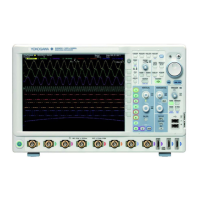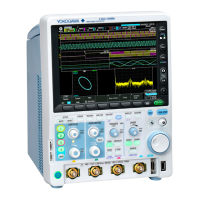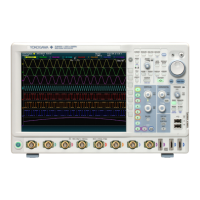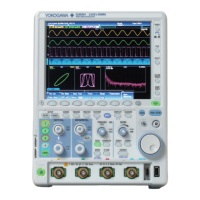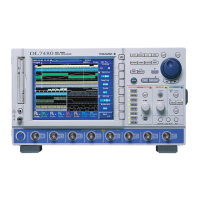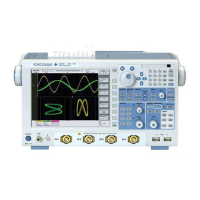4-7
IM 710105-17E
Programming Overview
4
• If a character string contains a double quotation
mark (
"
), the double quotation mark is expressed as
two consecutive quotation marks (
""
). This rule also
applies to single quotation marks.
• A response message is always enclosed in double
quotation marks (
"
).
• <String data> is any character string. Therefore,
the DLM2000 assumes that the remaining program
message units are part of the character string
if no single (
'
) or double quotation mark (
"
) is
encountered. As a result, no error is detected if a
quotation mark is omitted.
<Filename>
<Filename> is data that indicates a file name. The
following types of expressions are possible.
Form Example
{<NRf>
|
<character data>
|
<string data>}
1 CASE "CASE"
• <NRf> is rounded to an 8-digit integer and converted
to ASCII code. The result is the file name (example:
1 becomes “
00000001
”). Negative values are not
allowed.
• For <character data>, the first 12 characters
become the file name.
• For <string data>, the first 259 characters become
the file name.
• Response messages are always expressed in the
<string data> form.
• For information about the number of characters in a
file name expressed in the <string data form>, see
the DLM2000 User’s Manual.
<Block Data>
<Block data> is any 8-bit data. It is only used in
response messages on the DLM2000. The syntax is as
follows:
Form Example
#N<N-digit decimal number><data byte sequence>
#800000010ABCDEFGHIJ
• #N
Indicates that the data is <block data>. “N” indicates
the number of succeeding data bytes (digits) in
ASCII code.
• <N-digit decimal number>
Indicates the number of bytes of data (example:
00000010
=
10
bytes).
• <Data byte sequence>
Expresses the actual data (example: ABCDEFGHIJ).
• Data is comprised of 8-bit values (0 to 255). This
means that the ASCII code “0AH,” which stands for
“NL,” can also be included in the data. Hence, care
must be taken when programming the controller.
<Register>
<Register> is an integer that can be expressed in
decimal, hexadecimal, octal, or binary notation. It is used
when each bit of the value has a particular meaning. The
following types of expressions are possible.
Form Example
<NRf>
1
#H<Hexadecimal value made up of the digits
#H0F
0 to 9 and A to F>
#Q<Octal value made up of the digits 0 to 7>
#Q777
#B<Binary value made up of the digits 0 and 1>
#B001100
• <Register> is not case sensitive.
• Response messages are always expressed in the
<NR1> form.
<Character Data>
<Character data> is a predefined character string
(mnemonics). It is mainly used to indicate that an
option listed as a character string in braces must be
selected and entered. The data interpretation rules are
the same as those described in “Header Interpretation
Rules” on page 4-4.
Form Example
{AC|DC|DC50|GND} AC
• As with the header, the
COMMunicate:VERBose
command can be used to select whether to return
the response in the full form or in the abbreviated
form.
• The
COMMunicate:HEADer
setting does not affect
<character data>.
<Boolean>
<Boolean> is data that indicates ON or OFF. The
following types of expressions are possible.
Form Example
{ON|OFF|<NRf>}
ON OFF 1 0
• When <Boolean> is expressed in the <NRf> form,
“OFF” is selected if the rounded integer value is 0,
and ON is selected for all other cases.
• A response message is always returned with a 1 if
the value is ON and with a 0 if the value is OFF.
<String Data>
<String data> is not a predefined character string like
<character data>. It can be any character string. The
character string must be enclosed in single quotation
marks (
'
) or double quotation marks (
"
).
Form Example
<String data>
'ABC' "IEEE488.2-1987"
4.4 Data

